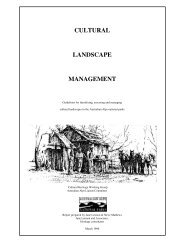Mining Heritage of the Australian Alps - Australian Alps National Parks
Mining Heritage of the Australian Alps - Australian Alps National Parks
Mining Heritage of the Australian Alps - Australian Alps National Parks
Create successful ePaper yourself
Turn your PDF publications into a flip-book with our unique Google optimized e-Paper software.
2.2 BRIEF HISTORY<br />
(Global & <strong>Australian</strong> context histories are included in Appendix 10)<br />
2.2.1 SUMMARY HISTORY<br />
Prelude<br />
There were three important precursors to mining in <strong>the</strong> <strong>Australian</strong> <strong>Alps</strong>. The first <strong>of</strong> <strong>the</strong>se was <strong>the</strong><br />
sparse European settlement established in lands in and adjoining <strong>the</strong> <strong>Alps</strong>. Graziers occupied land<br />
around <strong>the</strong> <strong>Australian</strong> <strong>Alps</strong> from <strong>the</strong> early 1820's in NSW, and it was <strong>the</strong>ir quest for good grazing<br />
lands that brought settlement in <strong>the</strong> mid-1830's to <strong>the</strong> Omeo area, geographically central to <strong>the</strong><br />
Victorian <strong>Alps</strong>. The thin European presence brought progressive exploration <strong>of</strong> <strong>the</strong> high country, and<br />
gradually <strong>the</strong> wildernesses were penetrated.<br />
The second important precursor was <strong>the</strong> discovery <strong>of</strong> payable gold in NSW in 1851, that started <strong>the</strong><br />
first gold rushes, and <strong>the</strong> subsequent Victorian discoveries that triggered <strong>the</strong> global rushes. These<br />
demonstrated that <strong>the</strong> continent (or at least NSW and <strong>the</strong> newly-created colony <strong>of</strong> Victoria), could<br />
produce unheard-<strong>of</strong> wealth from <strong>the</strong> ground, and <strong>the</strong> rate <strong>of</strong> new & widespread discoveries in itself<br />
demonstrated that this wealth was not localised, but could occur anywhere.<br />
The third important precursor was <strong>the</strong> discovery <strong>of</strong> major goldfields adjacent to <strong>the</strong> <strong>Alps</strong>, that drew<br />
large numbers <strong>of</strong> miners and prospectors to <strong>the</strong> foot <strong>of</strong> <strong>the</strong> <strong>Alps</strong>. In Victoria, <strong>the</strong> key discoveries were<br />
Beechworth in 1852, where thousands <strong>of</strong> miners rushed to north-east Victoria, and Omeo in 1851. In<br />
NSW, <strong>the</strong> key discoveries were to <strong>the</strong> west, at Tumbarumba in 1855, and Adelong in 1857 - <strong>the</strong>se<br />
followed earlier discoveries in <strong>the</strong> coastal ranges to <strong>the</strong> east, Araluen and Braidwood in 1851.<br />
Gold & O<strong>the</strong>r Metals<br />
The diggers who were attracted to Beechworth, in north-east Victoria, wasted no time in prospecting<br />
<strong>the</strong> surrounding country. Yackandandah was quickly opened, and a party <strong>of</strong> prospectors led by <strong>the</strong><br />
American, Pardoe, prospected up <strong>the</strong> Ovens River to its source in <strong>the</strong> <strong>Alps</strong>, in 1853. They <strong>the</strong>n<br />
followed <strong>the</strong> Buckland River downstream, until <strong>the</strong>y found rich gold, and <strong>the</strong> ensuing rush attracted<br />
six to eight thousand miners. While <strong>the</strong> earliest, richest diggings were upstream <strong>of</strong> <strong>the</strong> boundary <strong>of</strong><br />
<strong>the</strong> present Mt Buffalo <strong>National</strong> Park, it is possible that <strong>the</strong> first diggings within <strong>the</strong> study area were<br />
undertaken here on <strong>the</strong> Buckland River, because all available ground was taken up for many miles<br />
along <strong>the</strong> valley floor.<br />
The spillover <strong>of</strong> late-comers to <strong>the</strong> Buckland spread along <strong>the</strong> upper Ovens River, establishing Bright<br />
(Morses Creek) by <strong>the</strong> end <strong>of</strong> 1853, and reaching Harrietville, at <strong>the</strong> junction <strong>of</strong> <strong>the</strong> East and West<br />
branches <strong>of</strong> <strong>the</strong> Ovens, by 1854. The small number <strong>of</strong> miners worked both branches at this period,<br />
and this is <strong>the</strong> first digging definitely attributable to <strong>the</strong> study area.<br />
On <strong>the</strong> Omeo side, <strong>the</strong> early 1851 diggings that had been abandoned were revitalised in 1854, and<br />
prospectors moved out to open up a series <strong>of</strong> rich alluvial goldfields, <strong>the</strong> first <strong>of</strong> <strong>the</strong>se within <strong>the</strong> study<br />
area being <strong>the</strong> Gibbo River in about 1855. Miners from Omeo opened <strong>the</strong> Cobungra diggings in<br />
1857, and gold was quickly traced to <strong>the</strong> headwaters, now within <strong>the</strong> Alpine NP. Miners moving up<br />
from <strong>the</strong> Upper Ovens crossed over Mt Hotham, and <strong>the</strong> first gold diggings in <strong>the</strong> Upper Dargo were<br />
opened in about 1858.<br />
In NSW, <strong>the</strong> Rev W B Clarke had explored <strong>the</strong> Snowy Mountains area in 1851-52 and reported traces<br />
<strong>of</strong> gold from various localities, but his valuable work appears to have been little-used. In 1859 <strong>the</strong><br />
Pollock bro<strong>the</strong>rs, accustomed to bringing sheep to <strong>the</strong> high country for summer grazing, and<br />
undertaking a little prospecting <strong>the</strong>mselves, discovered <strong>the</strong> rich gold deposits <strong>of</strong> Kiandra. They<br />
reported <strong>the</strong>ir find in <strong>the</strong> established gold mining town <strong>of</strong> Tumbarumba, and <strong>the</strong> greatest rush <strong>the</strong> <strong>Alps</strong><br />
9

















